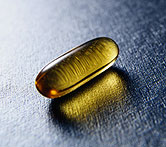
MONDAY, Nov. 19 (HealthDay News) — Pregnant women with higher levels of vitamin D circulating in their blood were significantly less likely to develop multiple sclerosis in the years after giving birth, a new Swedish study suggests.
Researchers also found that vitamin D blood levels had decreased gradually since 1975 in those tested, possibly providing clues as to why MS has become more common in industrialized parts of the world.
“It seems that vitamin D might help twist the immune system towards a more non-inflammatory state, and this has been suggested as one of the [presumed] mechanisms by which vitamin D might influence MS risk,” said study author Dr. Jonatan Salzer, a doctoral student in pharmacology and clinical neuroscience at Umea University. “The finding does, however, need confirmation in a different [group] before it’s considered a ‘true’ finding, as is generally the case with these kinds of research results.”
The study is published in the Nov. 20 online issue of the journal Neurology.
Thought to be an autoimmune disorder, MS affects about 400,000 people in the United States, according to the National MS Society. The disease attacks the fatty sheath protecting nerves in the central nervous system, causing disabling symptoms such as blurred vision, loss of balance, bladder and bowel difficulties, slurred speech, numbness and extreme fatigue.
Salzer and his team reviewed results from 291,500 blood samples collected from 164,000 people in the northern part of Sweden since 1975, including 124,000 samples from pregnant women. Women who had high blood levels of vitamin D were 61 percent less likely to develop MS compared to those with low levels.
However, no link was found between the mother’s vitamin D levels and whether her child would later develop MS. These findings contradict a study published last week in the Journal of Neurology, Neurosurgery and Psychiatry that strongly implicated maternal exposure to vitamin D during pregnancy, concluding that MS risk is lower among those born between October and November, after months of vitamin D-producing sunlight exposure.
In the current Neurology study, high blood levels of vitamin D were defined as readings of 75 nanomoles per liter (nmol/L) or above. The Institute of Medicine, a non-profit group affiliated with the U.S. National Academy of Sciences, has said people should aim for blood levels of 50 nmol/L, which can be achieved with vitamin D supplements of 600 international units (IU) per day, or 800 IU for those older than 70.
Salzer noted that scientists don’t yet know if one source of vitamin D — whether sunlight, diet or supplements — affects blood levels more than another, calling it “the $10,000 question.”
“Sunlight, and its UVB radiation, has immune-modulating properties apart from generating vitamin D, and these effects might actually influence MS risk as well,” Salzer said. “Given the current knowledge, however, I’d say that the case for vitamin D is stronger than for sunlight in itself.”
Dr. Karen Blitz-Shabbir, director of the Multiple Sclerosis Center at Cushing Neuroscience Institute in Manhasset, N.Y., said she recommends blood tests measuring vitamin D levels for all her patients and would for the general population as well. She also recommends vitamin D supplements for all, noting that the much-researched vitamin has also been shown to hinder the systemic inflammation that can contribute to other serious conditions such as heart disease and cancer.
“Everything we see points to the value of vitamin D in MS,” she said. “This study makes absolute perfect sense.”
While the study found an association between lower vitamin D levels in pregnancy and MS risk, it did not prove a cause-and-effect relationship.
More information
Visit the National MS Society to learn more about multiple sclerosis.

